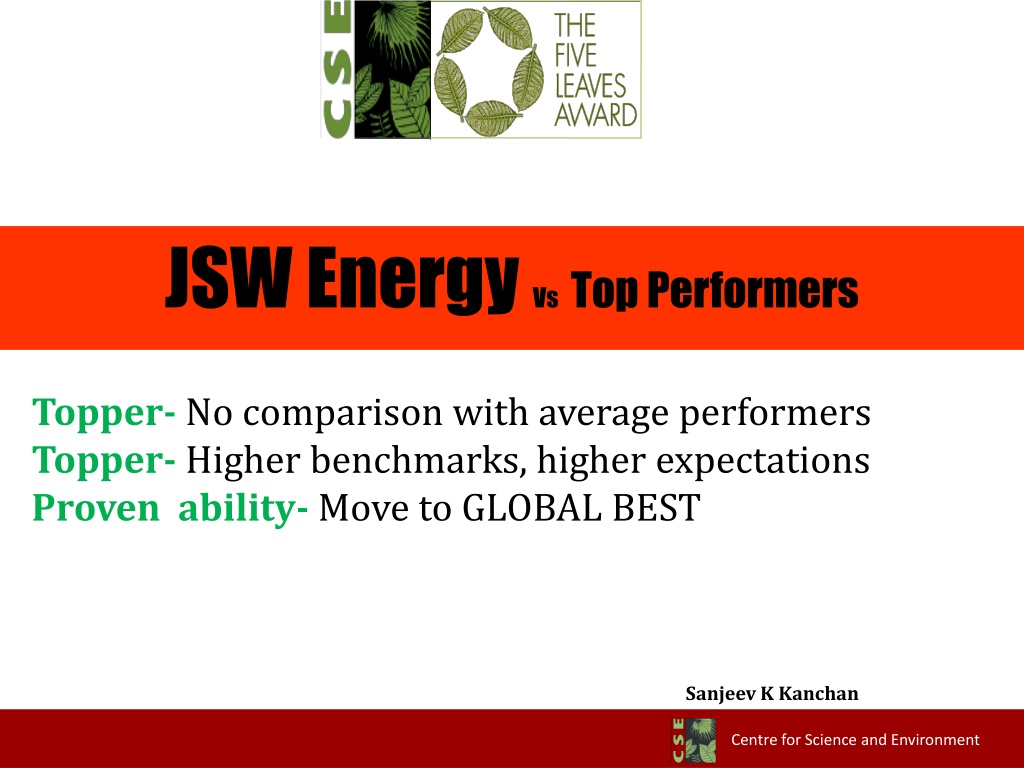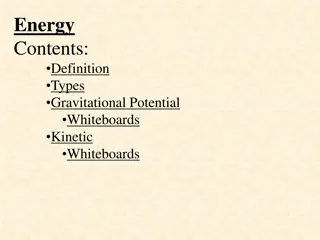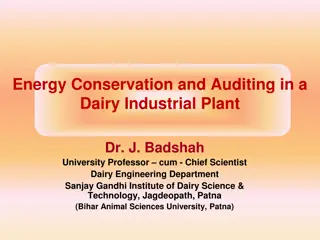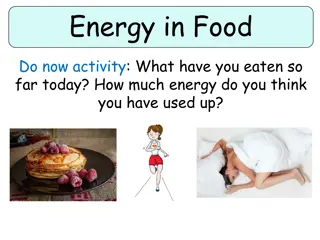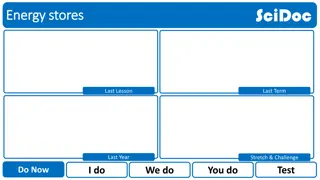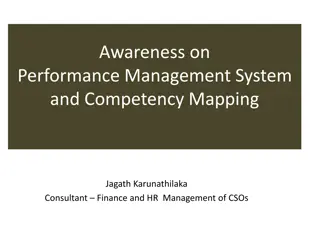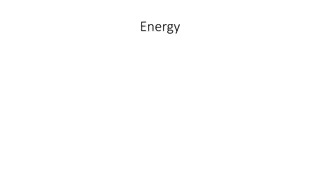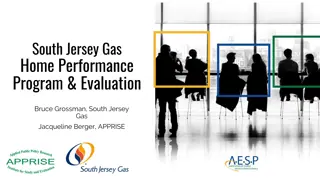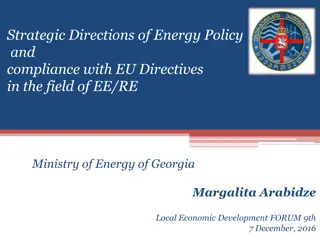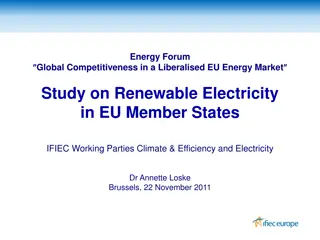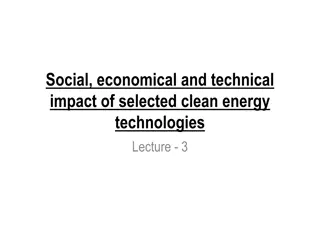JSW Energy Performance Analysis Overview
Analyzing the performance of JSW Energy in comparison to top performers across various categories like energy efficiency, water management, air pollution control, and solid waste handling. The data showcases JSW Energy's strong capabilities, higher benchmarks, and proven ability to excel on a global scale. Detailed insights are provided on key parameters and comparisons with other industry players, highlighting JSW Energy's position as a top performer. Visual aids supplement the analysis conducted by Sanjeev K. Kanchan from the Centre for Science and Environment.
Download Presentation

Please find below an Image/Link to download the presentation.
The content on the website is provided AS IS for your information and personal use only. It may not be sold, licensed, or shared on other websites without obtaining consent from the author.If you encounter any issues during the download, it is possible that the publisher has removed the file from their server.
You are allowed to download the files provided on this website for personal or commercial use, subject to the condition that they are used lawfully. All files are the property of their respective owners.
The content on the website is provided AS IS for your information and personal use only. It may not be sold, licensed, or shared on other websites without obtaining consent from the author.
E N D
Presentation Transcript
JSW Energy Vs Top Performers Topper- No comparison with average performers Topper- Higher benchmarks, higher expectations Proven ability- Move to GLOBAL BEST Sanjeev K Kanchan Centre for Science and Environment
Score Comparisons Energy JSW JSW Total Weight Best in Category JPL Raigarh Torangallu (% score) Ratnagiri (% score) Best in parameter Plant Gross Heat Rate and Trends Design Gross Heat Rate, and Tech 7.0 36.8 26.2 34.0 37.6 Tata, Mundra 5.0 47.8 49.9 43.8 64.0 Tata, Mundra Avg. Auxiliary 2.0 45.1 21.0 33.5 80.0 Tata, Trombay Deviation from Design Heat rate 3.0 57.1 0.0 80.0 80.0 JPL, Raigarh Availability 3.0 0.0 0.0 56.56 75.00 Dahanu Total Weight 24.0 9.6 6.2 11.7 Note- Other parameters: Sec. fuel, avg size, GHG Among top performers: < 92% PAF Ratnagiri- Deviation in GHR >12% , Aux ~9% Centre for Science and Environment 2
Score Comparisons Water Total Weight Torangallu (% score) Ratnagiri (% score) Best in Category Ratnagiri Best in parameter Water Sources 4 50 75 75 75.0 Sp. Water consumption 5 62 50 50 64.0 GIPCL Water Stress 3 10 100 100 100 Total Weight 16 or 12 8.39 / 16 8.5 / 12 8.5 Note- Other parameters: water use in ash handling, COC Toranagallu- uses 13% COREX (Bellary water stressed) Can consumption be further reduced? Ratnagiri- Sea water based Centre for Science and Environment 3
Score Comparisons Air Pollution Total Weight Torangallu (% score) Ratnagiri (% score) Best in Category Ratnagiri Best in parameter (% score) PM 4 53 56 56 69 Budge Budge SO2 2 0.0 0.0 0.0 61 Trombay Pollution Control Tech 2 41 50 50 100 NTPC Singrauli Coal Storage & Handling 6 25 88 88 88 JSW Ratnagiri Total Weight 19 5.3 8.5 8.5 Note- Other parameters: AAQ index Estimated SO2 (FGD plant- given value); compared against Chinese norm. Centre for Science and Environment 4
Score Comparisons Water Pollution Torangallu (% score) Ratnagiri (% score) Best in Category NLC Barsingsar Best in parameter (% score) Total Weight 100 Score for ETP, STP 1 50 100 100 100 Water Pollution Index 4 100 20 100 Total Weight 7 5/7 3/7 6/7 Note- Other parameters: coal run-off treatment, CSE lab test Ratnagiri- Water pollution related complaints Centre for Science and Environment 5
Score Comparisons Solid Waste Toranagallu (% score) Ratnagiri (% score) Best in Category GIPCL Surat Best in parameter (% score) Total Weight Type of Ash handling 2 100 100 100 100 Many Ash Utilization >100 Mettur, Torrent 1 0 0 100 Gainful Ash Utilization >100 Mettur / RRVUNL Kota 5 8 69 89 Torangullu / NLC - Barsingsar Ash Pond Maint. 4 80 40 60 80 Total Weight 15 7.59 8.27 11.03 Note- Other parameters: stakeholders observation ash pollution Imported coal at-least 80% ash use criteria (domestic coal at-least- >58%) Gainful- Imported at-least- 33% (Domestic at-least- 48%) Ash pond maintenance- Ratnagiri- bund, pipeline 6 Centre for Science and Environment
JSW- Toranagallu Energy SBU-I (2x130 MW)- in 2000, SBU-II (2x300 MW)- 2009 Avg. GHR - 2,261kCal/kWh (38 %), design GHR 2,162 kCal/kWh, (BAT- <1,800kCal/kWh, Nordjylland-Denmark) Deviation - 4.6% (Hissar, Mundra etc.- <1%) Auxiliary -7.6 % (Maithon/Hissar etc.- ~6%) PAF- 90.9%; PLF- 94% (PAF- 99%, PLF- >100%) Sp. Coal consumption at 0.46 kg/KWh (13% energy from COREX) Water Water stress area ZLD, Sp. Water- ~2m3/MWh {Best- 1.6 ; Dry- 0.11(m3/MWh)} COC of 5-7 (Jojobera- 8, achievable 10) Centre for Science and Environment 7
Issues to Deal Community complaints- Red dust emission (steel), vehicular movement through village (steel, power, mines) CSR (< 2% of profit)- demand for more access to heath facility Study of impact (of complex) on Daroji bear sanctuary Centre for Science and Environment 8
JSW- Toranagallu Solid Waste Dry ash handling; Bottom as- Dry/Semi-wet Ash use-79%; (Budge Budge, Torrent, Mettur, Kota etc.- >100%) Gainful use- 51 % (Mettur, Kota- >100%) Air Pollution No visible emission PM- 60-62 mg/Nm3 (norm 100 mg/Nm3) SO2- 665-934 mg/Nm3 NOx- 366-429 mg/Nm3 No mercury emission monitoring (Implication of new pollution norms) ? CEMS ? Centre for Science and Environment 9
JSW- Ratnagiri Energy 300 MW x 4 - in 2010/11 Avg. GHR - 2,418kCal/kWh (35.5 %), design GHR- 2,151 kCal/kWh (39.9%), (BAT- <1,800kCal/kWh, Nordjylland- Denmark) Deviation - 12% (Hissar, Mundra etc.- <1%) Auxiliary ~9 % (Maithon/Hissar etc.- ~6%) PAF- 89%; PLF- 81% (PAF- 99%, PLF- >100%) Sp. Coal consumption at 0.49 kg/KWh (Imported) Covered coal storage- only one in India Water Sea water with CT- Sea water requirement- 9.7m3/MWh Issues to deal- Ground water contamination, CT saline mist Centre for Science and Environment 10
Issues to Deal Community complaints- Saline mist & leakage from CT, coal dust emission, hot CW discharge - Impact on orchards, fishes How to convey your work/improvement? Centre for Science and Environment 11
JSW- Ratnagiri Solid Waste Dry ash handling Ash use-77.6%; (Budge Budge, Torrent, Mettur, Kota etc.- >100%) Gainful use- 83.8 % (Mettur, Kota- >100%) Issues to deal- ash pond maintenance, ash transport pipeline, complaints on ash emissions Air Pollution No visible emission PM- 9-24 mg/Nm3 (norm 50 mg/Nm3) SO2- 373-405 mg/Nm3 NOx- not monitored No mercury emission monitoring (Implication of new pollution norms) ? CEMS ? Centre for Science and Environment 12
Implication of new pollution norms Implication of new pollution norms Installed before Dec 31st, 2003 (shall meet within 2 yrs) Installed after Dec 31st, 2006 (shall meet within 2 yrs) Installed Jan 1, 2017 onwards (Includes accorded EC, under construction) Pollutan ts Unit size PM All 100mg/Nm3 50 mg/Nm3 30 mg/Nm3 <500MW 600 mg/Nm3 -- -- SO2 >=500MW All >=500MW 200 mg/Nm3 600 mg/Nm3 0.03 mg/Nm3 200 mg/Nm3 300 mg/Nm3 0.03 mg/Nm3 100 mg/Nm3 100 mg/Nm3 0.03 mg/Nm3 NOx Hg Centre for Science and Environment 13
Implication of CEMS ? Implication of CEMS ? CEMS- Selection, installation, certification, calibration/re-calibration, daily check, data recording, record keeping, compliance check, publish Device health check- daily 10.00 a.m.; zero drift calibration verification- 3 months Zero and span drift every week >85% data capture Data verification/ calibration- 6 monthly by empanelled Lab Compliance Any exceedance- violation Data spikes (< 1 min)- not for avg Continuous exceedance upto 10% of norms, o >30 mins- preventive action by industry o >60 mins- to inform SPCB/PCCs about preventive action o Second time- closure Frequent exceedance- > 5% of data/day- action by SPCBs/PCCs Industry fails to control emissions- closure as per SOP Start-up/shut down ( batch process for 30 mins)- not for avg Centre for Science and Environment 14
